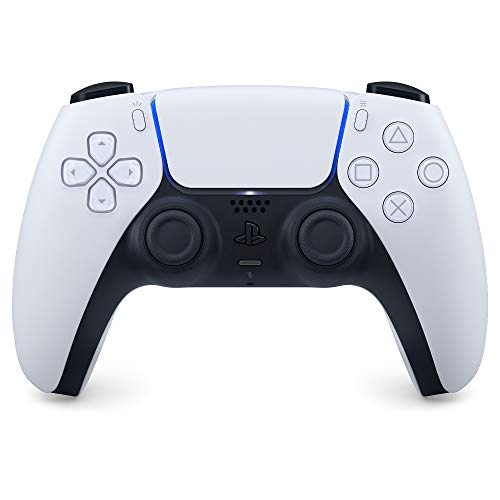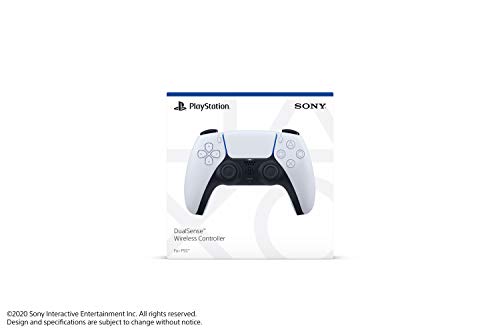Description
The DualSense, Sony’s name for the native PlayStation 5 controller makes the most of the possibilities a new generation of consoles offers. The DualShock 4 successor has a strong new look and a redesigned shape that is easier on the hands, making it a better, more interesting controller in essence. It also has some next-gen swagger: through tactile feedback, beautifully implemented next-gen haptics and adaptive trigger resistance create possibilities for more immersive experiences. DualSense sets a strong new standard for console controllers, both a careful evolution and a big, innovative leap.
DualSense Sony-Design and Features
The general shape may look very similar to the DualShock 4, but some incredibly bold changes to the formula are made by the DualSense, both large and small. Although the overall shape has changed only slightly, 6.25 x 4.22 x 2.47 inches (WDH) compared to the 6.22 x 3.94 x 2.44 of the DualShock 4, it has longer, beefier handles that rest and fit better in your hands because the grip of the controller is simply greater. Weighing 282 grams, it’s considerably heavier than the 215 grams of the DualShock 4. However, that weight is well-balanced and ultimately leads to a feeling of more comfort as you hold it.
The DualSense feels like a dramatic shift from the DualShock 4 aesthetically. After three generations of discreet, single-color Sony gamepads, its smooth curves and two-tone color scheme, white with black accents, including the analog sticks and triggers, by default, feels like a paradigm change. And there’s incredible attention to detail: from the way the side panels flare up to the textured grip on the back panel, which is actually made using tiny, almost indistinguishable versions of PlayStation face button shapes, just a little bit on either side of the touchpad.
The design of the DualSense is more or less intact from the DualShock 4, but some of the buttons have some interesting new changes, as well as new features that enhance gameplay in exciting ways. Now white with grey symbols, the buttons and D-pad push back faster than their predecessors and have a little more travel: both make them feel less squishy and give a better feeling of feedback. There is a clear sound and feel when you fully press the face buttons or D-pad, although I wouldn’t call them clicky.
The “Share” button has been replaced in the center column with a “Create” button, and a system-level menu is pulled up, allowing you to choose between taking screenshots, recording a clip of what just happened, or starting a new recording. The DualShock 4 touchpad returns, but with an RGB light bar around the edge, it is now matte white. Below that, alongside a logo-shaped PS button, the built-in speaker is back as well.
The new built-in microphone is located below the PS button. The mic just looks like a tiny dot on the outside, like the internal microphones on the Pulse 3D headset and Sony’s Bluetooth headphones, but is capable of picking up anything and everything right around it. It also technically adds additional control options in at least one game: in Astro’s Playroom, you are asked to blow into the mic to progress at certain points. There’s a thin clear mic mute button just below the PS logo if you find the idea of having a hot mic in your hands unnerving.
The DualSense is Sony’s best controller to date, regardless of the new features.
The biggest, most exciting changes deal with the triggers if you swing back around. L2 and R2 are longer, with a deeper pull that I think helps maximize the effect of the two most significant new features of DualSense: accurate haptic feedback and the so-called “adaptive triggers” that create resistance in them to simulate tension or otherwise provide physical feedback. And although the haptics is present throughout the controller, through the triggers, the most interesting, accurate feedback comes. The two characteristics make the triggers the centerpiece of the DualSense, working in tandem. They are not only critical inputs but the main conduits through which you “feel” what a game is trying to tell you.
The PS4 light bar has also been removed from the back, and the micro-USB charging port has been replaced by a USB-C port, which allows both fast chargings and is reversible for easier plug insertion. However, in Sony’s controllers, the life of the inner rechargeable battery is still a low point to which the DualSense has not come up with a solution. I found a full charge lasts around 10 to 13 hours in my personal testing, which is long enough so you don’t need to charge it every day but short enough that if you don’t, you will often find yourself running low on power.
The leap from DualShock 4 to DualSense really feels like an experience for the next generation. The refined design and new characteristics of the DualSense do wonders for PlayStation gaming when playing some of the PS5’s launch lineup, including Astro’s Playroom, Spider-Man: Miles Morales, and Bugsnax.
The DualSense is Sony’s best controller to date, regardless of the new characteristics. For long stretches, its bigger chassis makes it easier to hold. Its buttons are more responsive and have a press which is more satisfying. While only very slight, the textured grip is enough to hold your hands in place even when they get sweaty. Even if there was nothing new it could do, it would still be an enormous upgrade.
Sony has both made a more convenient gamepad for traditional gameplay with the DualSense, and introduced some very exciting features. In games that use them the haptics and adaptive triggers make an immediately noticeable distinction and offer the exciting potential for new and interesting gameplay experiences. The DualSense controller is everything that you want to see in a next-gen upgrade, except for battery life, which remains a weak point.



